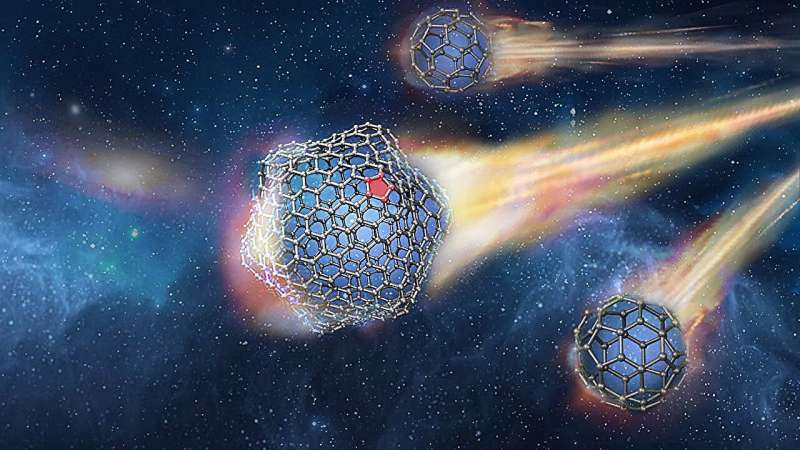
November 12, 2024 by IMDEA Materials
Collected at: https://phys.org/news/2024-11-macroscopic-propagation-topological-metamaterials.html
Researchers have taken a novel approach to studying the interaction between certain topological metamaterials and sound wave propagation.
The technique, described by IMDEA Materials’ Dr. Johan Christensen as “cut-and-glue,” was one of the methods employed in the recent publication “Visualizing the topological pentagon states of a giant C540 metamaterial” in Nature Communications.
The study focuses on Buckminsterfullerene, or “buckyballs,” and uses 3D printing to scale up the molecular structure of a C540 fullerene, which typically has an approximate diameter of around 1.1 nanometer (nm). To put that size into perspective, it is roughly 70,000 times smaller than the width of a human hair.
The macroscopic C540 model, which features a network of interwoven hexagons and pentagons, allowed scientists to explore sound wave behavior and energy confinement in a structure inspired by carbon allotropes, but on a scale large enough to observe directly.
Fullerenes, or C60, are spherical carbon molecules with 12 pentagonal and 20 hexagonal faces. These molecules have been synthesized through laser evaporation and found in rare natural materials such as shungite rocks and carbon-rich stars.
“While fullerenes exhibit unique electronic properties, observing these properties at the nanoscale is challenging,” explained Dr. Christensen, one of the paper’s authors. “By creating a larger, 3D-printed C540 model, we were able to overcome this limitation, gaining insights into how sound waves interact with the structural defects, known as topological states, within the carbon lattice.”
The 3D-printed C540 structure was made up of hollow tubes arranged in a network of pentagons and hexagons. This construction enables the study of how sound waves propagate through it, with a focus on how the pentagonal defects affect wave behavior.
“By visualizing these resonant modes, we are able to see how waves interact with topological defects, which is otherwise difficult to observe in smaller, synthesized molecules,” added Dr. Christensen.
In order to create the C540 model, researchers created and then scaled up a homogenous sheet of graphene, a 2D material with the thickness of a single atom. They then took advantage of their cut-and-glue technique to cut the sheet into wedges before reattaching them in a soccer ball-like form to create regions of strain and curvature within the structure.
This technique mimics the topological defects found in carbon materials such as graphene and nanotubes. These defects have been known to influence the behavior of electronic waves as they travel through the material, leading to regions where waves are confined and behave in distinctive ways.
By manipulating these topological features, researchers demonstrated that they could control wave propagation, which could have significant applications in waveguiding, sound insulation, and other acoustic technologies.
The next step for researchers will involve research into more complex fullerene symmetries through collaboration with former IMDEA Materials Visiting Researcher, Prof. Humberto Terrones from Rensselaer Polytechnic Institute.
Researchers included members from IMDEA Materials and IMDEA Nanoscience, in collaboration with the Materials Science Institute of Madrid (ICMM-CSIC) and Nanjing University. This partnership will see researchers focus on onion multilayer structures, with a particular interest in unlocking new symmetry rules by considering flexural vibrations instead of sound waves. These results may prove relevant for ultrasonic applications.
More information: Danwei Liao et al, Visualizing the topological pentagon states of a giant C540 metamaterial, Nature Communications (2024). DOI: 10.1038/s41467-024-53819-9
Journal information: Nature Communications

Leave a Reply